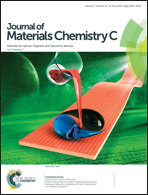Influence of the aryl spacer in 2,5-dialkoxyphenylene and diaryl substituted thieno[3,4-c]pyrrole-4,6-dione copolymers†
Abstract
Polymerization conditions for direct arylation polymerization (DArP) now allow for the preparation of conjugated polymers, such as donor–acceptor copolymers, where undesired couplings (donor–donor, acceptor–acceptor, or branching defects) are undetectable. This allows for the pursuit of more complex polymer architectures with multiple sites for potential C–H activation, which were previously avoided. Using these conditions, a series of 2,5-dialkoxyphenylene and diaryl substituted thieno[3,4-c]pyrrole-4,6-dione (TPD) copolymers were prepared in order to study the effect of the aryl substituents on the polymer bulk-heterojunction solar cell performance using PC61BM as the acceptor. A material design methodology is investigated, where distancing the sterically incumbered phenylene donor from the TPD acceptor using an aryl spacer is shown to provide improved solar cell performance. The aryl groups incorporated on TPD include bithiophene (BT), thienothiophene (TT), thienylene-vinylene-thienylene (TVT), and ethylenedioxythiophene (EDOT). The BT based copolymer was shown to have the highest performance with a short-circuit current (Jsc) of 10.54 mA cm−2, an open-circuit voltage (Voc) of 0.74 V, and a fill-factor (FF) of 0.61 affording a power conversion efficiency of 4.76%, which is the highest reported efficiency for a 2,5-dialkoxy phenylene copolymer prepared using DArP to the best of our knowledge.
![Graphical abstract: Influence of the aryl spacer in 2,5-dialkoxyphenylene and diaryl substituted thieno[3,4-c]pyrrole-4,6-dione copolymers](/en/Image/Get?imageInfo.ImageType=GA&imageInfo.ImageIdentifier.ManuscriptID=C8TC00823J&imageInfo.ImageIdentifier.Year=2018)


 Please wait while we load your content...
Please wait while we load your content...